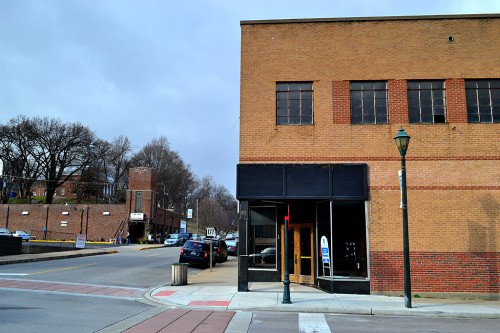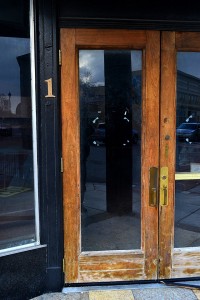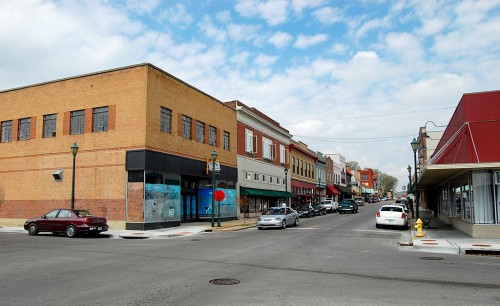 I learned about taxes in the Woolworth Store that stretched from Main Street to Spanish Street at the corner of Independence.
I learned about taxes in the Woolworth Store that stretched from Main Street to Spanish Street at the corner of Independence.
I must have been about six years old, with a dollar bill burning a hole in my pocket. Where I got that much money all at one time is a mystery, but I managed to convince my parents to let me go to Woolworth’s, known also as the Five and Dime, to buy a toy. The toy section, if I remember correctly, was toward the west end of the store, so we likely walked through these very doors to get to the Promised Land. The lunch counter, with its distinctive sound of clinking silver on heavy china was on the north wall just east of the toys.
 After looking at everything except the girly stuff, I settled on a stub-winged, olive-drab, friction-drive airplane, which may still be in Mother’s attic if my destructive younger brothers didn’t get hold of it. It cost 99 cents. Army toys – not action figures, which are just dolls for boys – were big with my age group. I’m pretty sure we were still fighting the Germans and not the Japs nor the Reds.
After looking at everything except the girly stuff, I settled on a stub-winged, olive-drab, friction-drive airplane, which may still be in Mother’s attic if my destructive younger brothers didn’t get hold of it. It cost 99 cents. Army toys – not action figures, which are just dolls for boys – were big with my age group. I’m pretty sure we were still fighting the Germans and not the Japs nor the Reds.
Clutching my plane in one hand and my dollar bill in other, I handed over my treasures to the cashier. She placed the plane in a brown paper bag and gave it back.
I waited patiently. Finally, I asked, “Where is my change?” Math was never my strong suit, but even in the first grade I understood that if you gave someone a piece of paper that represents 100 pennies to buy something that costs 99 pennies, you should get a penny back. (I had not been introduced to the concept of tipping yet.)
“There’s a penny tax,” she explained. “You don’t get any change. You had just enough for your purchase.”
“Tacks? I didn’t buy any tacks”
 “Tacks?” I said in a bewildered tone, “I didn’t buy any tacks. I just wanted the airplane.”
“Tacks?” I said in a bewildered tone, “I didn’t buy any tacks. I just wanted the airplane.”
Where’s my money go?
That was just about as disappointing as when I found out that the Farmers and Merchants Bank didn’t operate like Scrooge McDuck’s Money Bin. I had been faithfully depositing spare bits of change with them every time I went to visit Dad, who had an office on the second floor of the bank. I assumed that I’d get back the same change I had given them. Nope. When I went to redeem my cash, they handed me paper dollar bills, which were nowhere near as exciting as a pocketful of change that you could jingle.
Life, I found, was full of unpleasant surprises.

Here is a Frony photo of Woolworth’s in 1959, along with links to more photos including the lunch counter crowd.
http://www.semissourian.com/blogs/flynch/entry/48980
I looked at the flood photos Frony took. I believe they were from the Flood of 1951. I remember going in Montgomery Ward across the street from Woolworth’s. To enter the store one had to walk a wooden plank walkway across the first floor to the steps near the rear of the building. They were doing business on the second and third floors with the first floor entirely under water. Someone had tied a handline with big red bobber off one of the upright boards and was fishing in the middle of the first floor! That is something you don’t forget even if you are only six years old!
I have a photo circa 1950’s with my dad, uncle, Vince Rueseler, et al. lunching at the counter in Woolworth’s. I’d be happy to share if you can tell me how to upload. I remember that counter fondly. It was a real treat to get a Coke as we weren’t allowed to have soda at home. That may have been the sole control our parents had over the six of us.
I too was very upset as a child when I found out I would not get my exact money back from the bank. It’s the little things that nobody bothers to tell you!
I believe that Woolworths had plastic tokens called mills, green and red that could be used for paying tax(s) on items. Green was a 1/2 penny and red 1? Can’t remember the correct amount and they could have been used elsewhere downtown but I kind of remember Woolworths for some reason.
Or the time I was in Osco’s and something cost less than a dollar – my dad told me I can “break the dollar”, to which I replied, “No, I’m not going to tear up my dollar!”
I wish taxes were just a penny on the dollar. I think when I was old enough to buy things, it was 4 cents.
By the way, if you’re still missing that penny, I have drawer-fulls of them.
The current Cape Girardeau sales tax level may have prevented the purchase.
Thought they used red/green plastic mills for tax(s) at Woolworths.